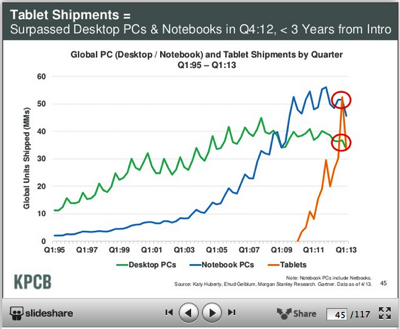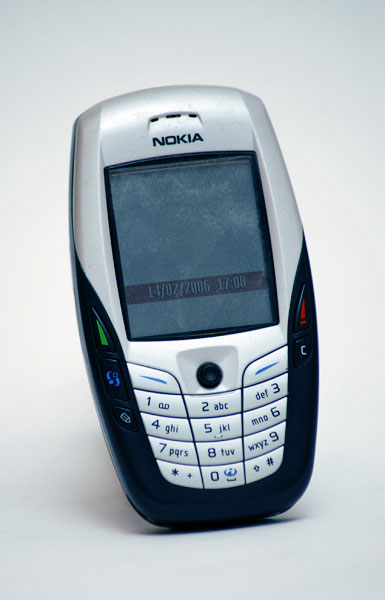Are Mary Meeker's Projections for Mobile Growth Dead Wrong?
I’ve spent a lot of time this week talking about the latest “state of the Internet” report from Mary Meeker with its mind-blowing statistics about the growth of the Internet generally, and mobile specifically.
But, as often happens, some are suggesting that Meeker is wrong. Very wrong. The surprising bit is these critics think Meeker’s projections are too conservative. As E-commerce Times notes:
“Meeker’s projected numbers for the increase in mobile traffic are too conservative, said James Lamberti, general manager and vice president of AdTruth.
‘Not only are we seeing a tremendous growth in mobile phones, but as she noted, tablets are also growing like wildfire, roughly three times faster than the iPhone…'”
OK, I don’t want to bash Mr. Lamberti, but he’s making a (potentially) huge mistake here: Assuming tablets are mobile.
Typically tablets are replacing desktops and laptops — outselling both in Q4 of last year (see the chart below).

But as I mentioned the other day, in practice, most customers don’t use their tablets outside the home.
Tablets aren’t desktops or laptops; they’re “couch computers,” a second screen your customers use while consuming other media. That’s not to say tablets aren’t a huge change in customer behavior (constant connection, mullti-device consumption, etc.) But they’re not mobile in the most meaningful sense of the word.
Of course, that still doesn’t answer the question as to whether Meeker is wrong. The answer to that reminds me of an old Bill Gates quote I mentioned on yesterday’s podcast:
“We always overestimate the change that will occur in the next two years and underestimate the change that will occur in the next ten.”
Gates couldn’t be more right. And there’s a good reason for this. The changes we’re seeing in the marketplace are driven by Moore’s Law, an understanding that computing power roughly doubles every 18 months. So the computing devices we’ll see in the next 18 months — mobile phones, tablets, wearables like Google Glass, etc. — will be twice as powerful at the end of 2014 as the devices we’re dealing with today. That’s not that hard to get your head around. (An alternative approach is to think that the tech you’re buying today will cost half as much in that same period).
So the problem isn’t the near-term. Many people look at how far we’ve come over the last 5-10 years and say, “OMG! You won’t believe where we’ll be in just the next year or two!” (To be fair, I may have done that myself once or twice).
But, that exponential growth really kicks into high gear when you look out 5-10 years. The doubling effect of Moore’s Law means that the devices 5 years from now will be 10 times as powerful as today (or 1/10th the price), while those 10 years from now will be 100 times powerful.
And that’s a hard reality to wrap your head around. Picture a Galaxy S4 or iPhone 5 selling for $5-$10. Picture one of the current iPads selling for eight or nine bucks. If you think I’m crazy, just remember that the best-selling “smartphone” in 2003 was the $600 Nokia 6600, a powerful device with Bluetooth, streaming video and audio, and the first camera phone to sell over 1 million units (cheaper phones existed, but they couldn’t do much).
If you’re curious, this technological marvel looked like this:
OK. Now imagine what you you’ll be able to buy a decade from now for $250, $500, $1000.
Tough to do, isn’t it?
So Meeker’s short-term projections may be off a bit. They may be a little bit optimistic or they may be conservative.
But the long-term picture blows my mind. Continually. We’re only now beginning to see how constant connectivity and instant access to information changes customer behavior. One thing that doesn’t seem to be happening is for that shift to slow down. Quite the contrary, in fact.
So I’m going to give Ms. Meeker the benefit of the doubt on this one. Your customers are snapping up mobile devices like they’re free candy. They’re expecting your site, your marketing, and your message to work from them across screens and across devices. And they’re only getting more accustomed to that reality. If Meeker’s numbers turn out to be a shade aggressive time-wise, you’re likely not too far ahead of the game given how many people already rely on mobile and tablets.
And if Meeker is too conservative? Well, brace yourself as the world turns upside down again.
Interested in learning more? Register to receive a free copy of my new special report, “Digital Hotel Marketing in a Multiscreen World,” produced in conjunction with Vizergy, here. While it’s targeted to the hospitality industry specifically, most of the lessons apply across verticals. And, if that’s not enough, you might also enjoy some of our past coverage of the social, local, mobile web, including:
Comments (3)
Leave a Reply
You must be logged in to post a comment.


Tim – is it not just a matter of time before tablet (like) devices start to replace laptops/desktops (do people still use desktops?) in the corporate office, at an accelerated pace? or do see a fundamental form factor/usability reason why that wouldn’t be expected?
Hi Kurt.
The short answer is “yes.” Tablets (or, very, very possibly, mobile phones), will definitely replace laptops/desktops in the not-too-distant future for most if not all users. And I think most e-commerce/digital marketing folks should be putting some serious effort into improving the overall mobile/touchscreen experience for their customers.
The long answer is a bit more complicated.
First, tablet sales have already bypassed desktops and laptops (separately, not combined — but that’s coming). Check out the data here if you haven’t seen it yet. Quite simply, for many users, tablets provide all the power they’re ever going to need. Plus, as you well know, Moore’s Law and all that ensures that from a pure power perspective they’ll be powerful enough for just about every application before too long. I would argue that most businesses should already equip their field sales forces — and anyone else whose main computing tasks involve email and showing the odd PowerPoint to customers — with nothing more than an iPad or Android tablet.
The question about usability is much more complicated, though. And on at least two levels, laptops/desktops (at the moment) still offer a couple of advantages: input devices and screen size.
First, input devices. For anyone needing to do a lot of content creation (serious Word docs, PowerPoint slides, Photoshop, etc.), touch interfaces don’t yet beat the keyboard/mouse/graphics tablet interfaces we all know and… tolerate. As someone who does lots of writing (reports for clients, white papers, email newsletters, 5-7 blog posts a week, etc.), tablets don’t yet allow a large enough/tactilely-satisfying experience to make me dump my QWERTY keyboard. Even younger folks, well-accustomed to texting, still tend to prefer larger keyboards when writing long papers and the like.
However, long-promised and equally long-under-delivered voice interfaces for computers look like they’re really and truly on the cusp of arriving (again, Moore’s Law at work). So, it’s possible that we’ll be able to start saying goodbye (pun intended) to the keyboard in many contexts before too long (say 5-7 years). And, let’s face it, other input devices already represent a largely niche group anyway. So, I do think that tablets can take the place of “traditional” PC’s for those use cases.
In either case, however, I think that tablets will begin to seriously eat into desktop e-commerce activity in the very, very near term. It’s already around 15%-20% for many businesses and that number’s going to grow significantly in the next couple of years. Now it’s up to all of us to think about how that changes customer behavior and develop better touch-aware interfaces. Most sites (including, unfortunately, this one), still work best with keyboard and mouse. That’s got to change. The companies that get that right in the next year or two stand to benefit significantly.
Screen size, on the other hand, poses a bigger question. While tablets can, theoretically, support larger screen sizes, at some point those screens become unwieldy and bulky enough that they lose whatever advantage they offer relative to laptop/desktop computers. So, I don’t know if increasingly large tablets represent the right answer.
What I think is more likely is that, over time, your actual device won’t matter. We’re not terribly far from a scenario where your customers can use voice-activation and motion control to access on-demand, cloud-based storage and processing and receiving the results both audibly and/or via a wirelessly-paired monitor. The tools all exist right now, if in “beta” forms. But check out the Xbox One and Google Conversational Search for examples. At that point, will we carry any computing devices? Will our “mobile phone” or “tablet” be little more than an uplink (though probably not a completely dumb terminal), providing authentication, connectivity, and some modest local processing for those brief periods when networks aren’t available? At which point, form factor becomes less relevant. I legitimately believe that current form factors represent only a temporary stop-gap until we reach this point. The question for me is more one of “how far away are we” than “will we get there.” (Though, to be fair, I’d be shocked if this hits the mainstream sooner than 5 years from now. The flip-side is I’ll be equally shocked if we’re still worrying too much about these types of form factors a decade out).
TL;DR: Tablets already represent a serious challenger to laptops/desktops for e-commerce applications and e-commerce/digital marketing folks need to take that into account right now. Longer-term, they’ll likely replace laptops/desktops for most applications. And, probably within 5-10 years, they’ll also fall by the wayside in favor of far more futuristic (in today’s terms), interfaces.
Thanks for reading and thanks for the thought-provoking comment. Great to see you here and looking forward to keeping the dialogue going.
Not to beat my comments to death (I wouldn’t do that, would I?), but have you seen AirPlay or Miracast? They allow devices (mobile phones, tablets, etc.), to connect wirelessly with TV’s, monitors, etc. and stream video (or share their screen). Add a Bluetooth keyboard, voice activation, cloud-based processing (for the really heavy lifting), and maybe gesture control, and you’ve got the situation I described in practice. Probably not mainstream for a while, but I’d be surprised if early adopters aren’t living this way (at least in part) already.